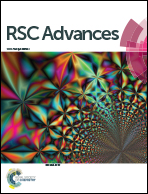Continuous synthesis of hedgehog-like Ag–ZnO nanoparticles in a two-stage microfluidic system
Abstract
Hedgehog-like Ag–ZnO nanoparticles (NPs) were successfully prepared in a continuous two-stage microfluidic system. The first stage was the synthesis of monodispersed triangular Ag nanoprisms by the reduction of AgNO3 with NaBH4 in the presence of trisodium citrate, H2O2 and sodium dodecyl sulfate. The second stage was the growth of Zn(OH)2 nanorods on triangular Ag nanoprisms to form a hedgehog-like shape. Hedgehog-like Ag–ZnO NPs were finally obtained by the thermal decomposition of as-prepared hedgehog-like Ag–Zn(OH)2 NPs. The structure, morphology and chemical state of the obtained samples were characterized by X-ray diffraction, transmission electron microscopy and X-ray photoelectron spectroscopy. It was found that H2O2, the molar ratio of NaOH to Zn(NO3)2 and the flow rate ratio of AgNO3 to Zn(NO3)2 played a crucial role in the preparation of hedgehog-like Ag–ZnO NPs. In addition, the photocatalytic activity of hedgehog-like Ag–ZnO NPs was evaluated in the degradation of methyl orange. The results showed that the photocatalytic activity was greatly enhanced by hedgehog-like Ag–ZnO NPs in comparison to pure ZnO and spherical-like Ag–ZnO NPs. The reaction rate constant of the hedgehog-like Ag–ZnO NPs was twelve times the value of pure ZnO and twice the value of spherical-like Ag–ZnO NPs.


 Please wait while we load your content...
Please wait while we load your content...